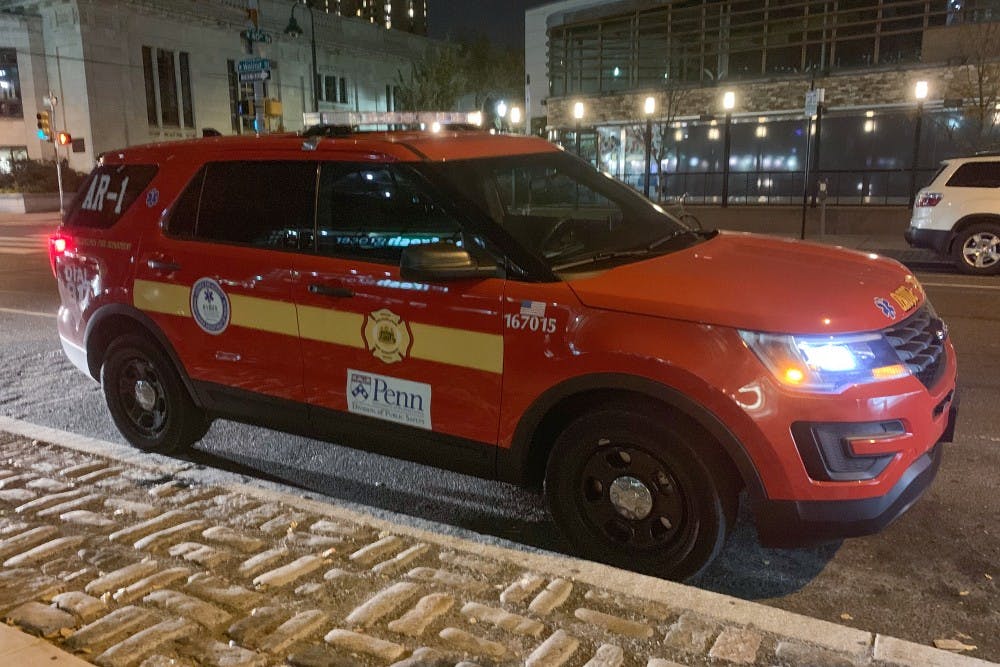Since Penn rolled out its free medical transport pilot program last fall semester, administrators have decided that the program is here to stay.
In September 2018, administrators introduced the program in an email to all undergraduate students. The transport program, called the "Alternative Response Unit," consists of one sports utility vehicle that is designed to replace ambulances for medical emergencies. The program was launched as a result of student input that the cost of an ambulance ride deters students from seeking medical assistance.
Under the transport program, when a student calls the Medical Emergency Response Team for a medical issue, they will be eligible to use the ARU at no cost should they need to be taken to the hospital.
At the time Penn launched the program, Vice President for Public Safety Maureen Rush said the pilot program's success would be evaluated in the spring, and they will decide if an additional SVU is needed. Rush said the Division of Public Safety will keep the program in place because of its success. Since its inception, the ARU has responded to approximately 152 dispatches as of April 9 during its hours of operation. The ARU will, however, continue operating with one vehicle.
The ARU is staffed with a Philadelphia Fire Department lieutenant paramedic and an EMT, with hours of operation between Wednesday through Saturday night from 5 p.m. to 3 a.m., according to DPS. During the ARU's operation hours, there have not been any ambulance bills.
The ARU is aimed to reduce medical fees for students. In past years, students facing medical emergencies have been able to call MERT for free. Once MERT conducted a medical assessment, however, it might have had to call on the Philadelphia Fire Department to transport the student to a hospital. The cost of this ambulance ride can range from $950 for Basic Life Support service to $1,170 for Advanced Life Support service, according to data from the Philadelphia Fire Department.
In the past, Philadelphia Fire Department ambulances would often be pulled out of other neighborhoods to respond to MERT calls and thus not be able to respond to emergencies in their respective neighborhoods, Rush said. The ARU uses its own SUV to respond to calls, ensuring that each neighborhood has access to its ambulance at all times.
The ARU also dramatically decreases the wait time for patients in need of medical transport, MERT Chief Gaby Ramirez said. The ARU vehicle is based on campus, while previously ambulances would have to be called in from more distant neighborhoods of Philadelphia.
RELATED:
Fling saw the lowest number of alcohol cases and citations in recent years
Why undercover police will be at Penn cracking down on underage drinking during Fling
Students agree that the ARU has been successful in reducing medical fees.
"I feel like it encourages kids to call MERT, because in the past they were just afraid of getting in trouble. I know there's the medical amnesty policy, but students are still afraid to pay the cost of the ambulance and tell their parents they have a huge bill like this, so [the ARU] kind of takes the fear away," College freshman Timothy Lee said.
Lee added that once he thought about sending his overly intoxicated friend to the hospital in an Uber. But he said using an Uber as a cheaper version of an ambulance is not the best idea because the student might need medical care while in the car.
However, students also said that the ARU could also introduce reckless drinking behavior.
College junior Christina Wei said the ARU could potentially decrease students' personal accountability for their decisions. College sophomore Karen Kim also said the ARU may normalize risky behavior with alcohol and drugs.
"Normalizing this kind of behavior puts students in danger, but also makes it unfair for those who get arrested for doing such things and not receiving the proper healthcare like Penn students are," Kim said.
Rush said there has not been a noticeable increase in MERT dispatches since the ARU has been put in place. If a student is transported twice by the ARU for reasons relating to drugs and alcohol, their family will receive a referral to the Office of Alcohol and Other Drugs.









